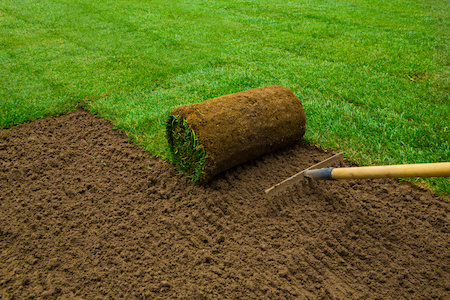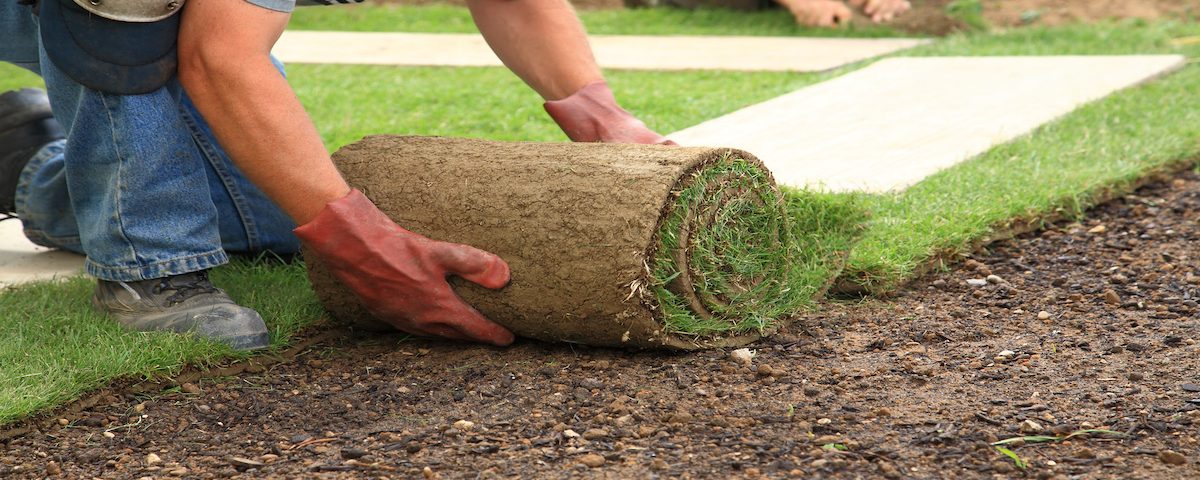
Our Clients:

How To: Soil Preparation Before Laying New Sod in Lynnwood WA

Are the Brown Spots in Your Lawn Snow Mold?
January 14, 2022
Is Hydroseeding a Good Choice for Chehalis?
May 11, 2022Before you lay your new sod grass, you need to prepare your soil. Good preparation not only gets your lawn off to a great start, but it also provides the foundation for healthy growth and a beautiful yard for years to come. Here are the essential steps to take before you lay your new sod lawn.
Clearing the soil
Remove old grass, weeds, and debris. Use a sod-cutter to remove any existing grass or sod. Rake and remove weeds, branches, bark, and big rocks.
Tip: Don’t cover old plants or debris with dirt or sod. Old plant material left under your new sod will steal nutrients and eventually produce a lumpy and struggling lawn.
If desired, you can treat the area prior to working the ground to reduce weeds in the future. Weed seeds and rhizomes can remain in the soil just waiting for the opportunity to grow. Apply a non-selective herbicide (one that works on both grasses and broadleaf weeds, i.e. Glyphosate) to the plant leaves before you clear the soil. Wait for the required time (following the label on the container) before you continue working the soil. Be sure the herbicide will not harm the new grass once installed.
Tip: If you don’t use herbicide to destroy weeds before you lay the sod, you can plan to work on broadleaf weeds later. Mowing regularly at the right height will kill most woody weeds that appear. Once the sod is established in your yard, you can spot-treat broadleaf weeds with a broadleaf herbicide. Undesirable grasses cannot effectively be treated after the fact.
Grading
You want a smooth and level surface for your new sod lawn. Remove high areas if needed. Fill low areas so the soil won’t remain continually wet. Create good water flow away from your house. Use a rake to remove rocks and debris as you work the soil. You can use a long straight item such as a ladder or wood post to smooth and level the surface.
Tip: Finish grade your soil to be ¾” below hard edges such as sidewalks and driveways. The new sod will then be at the right height for appearance and mowing efficiency.
Adding topsoil
Add soil as needed to level out the low spots, improve your soil, and to form a slope away from your house. Mix the new soil into your existing soil with a rototiller. Mix well to a depth of 4” to 6”.
Tip: Buy topsoil from a reputable material company. Sandy loam topsoil that has been screened to remove rocks and debris is ideal because it drains freely and is less likely to have weed seeds. Avoid high-nitrogen or high-organic soils that are designed for growing vegetables or flowers.
Tip: Never work saturated soil with a tiller or other equipment in wet conditions. This can ruin soil structure and lead to drainage problems and compaction far into the future.
Adding lime
Soils in Western Washington tend to be acidic and benefit from adding lime to reduce acidity. Another way to say it is you want to increase the pH level of the soil. Turfgrass grows best at a pH level of 6.0 to 7.5. Spread the lime over the soil or over the lawn after installation.
Tip: You can get your soil tested to determine the acidity level. It will almost always show a low pH level. A good rule of thumb for yards in Washington State west of the Cascades is to add 50 pounds of lime per 1,000 square feet.
Rolling and final raking
When you have the soil graded to your satisfaction, it’s almost time for the sod. Rent a water roller. It’s a big drum with a handle. Use your hose to fill the drum a third to a half full. Simply pull the drum around your yard. This firms the soil without compacting it. Then, for the final touch, gently drag a rake over the soil. The rake creates a good surface for the sod. A thorough watering to moisten the soil down to one inch and you are ready to begin placing your sod rolls. This wet soil will keep the soil from drawing moisture out of your sod.
Tip: As you do your final raking and preparation, continue to remove debris and big rocks that collect on the surface.
What to do about clay soil
Western Washington has many types of soils, from gravelly or sandy loam to silty clay. One area with clay soil is Snohomish County. For instance, if you’re in Lynnwood and your soil is slick, sticky, or soupy in wet weather and hard and dry in dry weather, you have soil with high clay content.
The first thought is usually to add sand. But it would take a tremendous amount of sand (more than a 50/50 ratio) to create a change in the soil and sand and clay combined make concrete.
The best preparation for clay soil is to rototill in some organic compost. Tilling opens up the silty soil and provides a good structure for turfgrass roots. Till it to a depth of 4” to 6”. If you add any topsoil, rototill again to mix the new topsoil with your existing soil.
Call Country Green Turf Farms!
Here at Country Green Turf Farms, we provide the highest quality of agricultural products in the Northwest. Since 1988, Country Green has been providing high-quality sod to meet any turf need that may arise. While we grow sod and provide it for different service needs, we also provide several other services to offer a comprehensive turf solution. Some of our other services include hydroseeding, fertilizer, landscape supplies and lawn establishment. For all your turfgrass needs call Country Green Turf Farms at 360-456-1006. We are your local trusted turf service providers. We provide affordable prices and much more!










